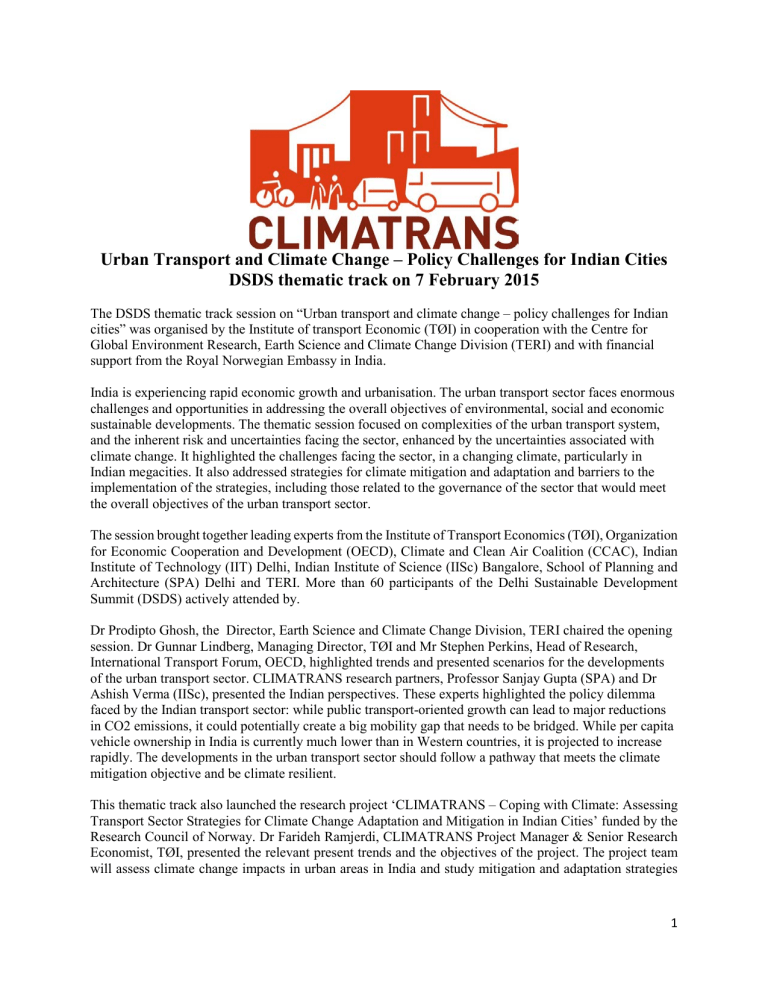Urban Transport and Climate Change – Policy Challenges for Indian

Urban Transport and Climate Change – Policy Challenges for Indian Cities
DSDS thematic track on 7 February 2015
The DSDS thematic track session on “Urban transport and climate change – policy challenges for Indian cities” was organised by the Institute of transport Economic (TØI) in cooperation with the Centre for
Global Environment Research, Earth Science and Climate Change Division (TERI) and with financial support from the Royal Norwegian Embassy in India.
India is experiencing rapid economic growth and urbanisation. The urban transport sector faces enormous challenges and opportunities in addressing the overall objectives of environmental, social and economic sustainable developments. The thematic session focused on complexities of the urban transport system, and the inherent risk and uncertainties facing the sector, enhanced by the uncertainties associated with climate change. It highlighted the challenges facing the sector, in a changing climate, particularly in
Indian megacities. It also addressed strategies for climate mitigation and adaptation and barriers to the implementation of the strategies, including those related to the governance of the sector that would meet the overall objectives of the urban transport sector.
The session brought together leading experts from the Institute of Transport Economics (TØI), Organization for Economic Cooperation and Development (OECD), Climate and Clean Air Coalition (CCAC), Indian
Institute of Technology (IIT) Delhi, Indian Institute of Science (IISc) Bangalore, School of Planning and
Architecture (SPA) Delhi and TERI. More than 60 participants of the Delhi Sustainable Development
Summit (DSDS) actively attended by.
Dr Prodipto Ghosh, the Director, Earth Science and Climate Change Division, TERI chaired the opening session. Dr Gunnar Lindberg, Managing Director, TØI and Mr Stephen Perkins, Head of Research,
International Transport Forum, OECD, highlighted trends and presented scenarios for the developments of the urban transport sector. CLIMATRANS research partners, Professor Sanjay Gupta (SPA) and Dr
Ashish Verma (IISc), presented the Indian perspectives. These experts highlighted the policy dilemma faced by the Indian transport sector: while public transport-oriented growth can lead to major reductions in CO2 emissions, it could potentially create a big mobility gap that needs to be bridged. While per capita vehicle ownership in India is currently much lower than in Western countries, it is projected to increase rapidly. The developments in the urban transport sector should follow a pathway that meets the climate mitigation objective and be climate resilient.
This thematic track also launched the research project ‘CLIMATRANS – Coping with Climate: Assessing
Transport Sector Strategies for Climate Change Adaptation and Mitigation in Indian Cities’ funded by the
Research Council of Norway. Dr Farideh Ramjerdi, CLIMATRANS Project Manager & Senior Research
Economist, TØI, presented the relevant present trends and the objectives of the project. The project team will assess climate change impacts in urban areas in India and study mitigation and adaptation strategies
1
for the transport sector, as well as barriers to their implementations, with a focus on Delhi, Mumbai and
Bengaluru.
These technical presentations were followed by a panel discussion on the policy challenges for transport in
Indian cities in the context of climate change. Mr. S. Sundar, Distinguished Fellow, Sustainable Habitat
Division, TERI, chaired this session. The panellists included Ms Hanne Bjurstrøm, Special Envoy, Ministry of Climate & Environment, Norway; and Co-Chair, Climate and Clean Air Coalition to Reduce Short-Lived
Climate Pollutants; and Prof Geetam Tiwari, MoUD Chair Professor for Transport Planning, Department of Civil Engineering, IIT Delhi. The panellists outlined their vision of a sustainable megacity for India and defined the role of the transport sector in this vision. The questions put forward to the panellists during the session by Ms Ulka Kelkar and Ms Neha Pahuja, TERI, and Ms Silvia Olsen, TOI, included:
1.
Your visions of a sustainable city for Indian cities, in particular mega cities, in the next 50 years, (for economic development, environment, liveability and equity). The role and the importance of the transport sector in responding to the image.
2.
What kind of policies are essential for low carbon growth of the urban transport sector, particularly in rapidly growing Indian cities? The policies could include integrated land us and transport policies, restrictions of car use (regulatory and pricing) alternative fuels technologies, promotion of public transport and non-motorised transport through planning and infrastructure investments
3.
Adaptation policies and coherence of mitigation and adaptation policies
4.
Role of the transport sector in provision of accessibility to the labour market, and integration of disadvantaged socioeconomic group, into the society
5.
Main barriers to achieve mitigation and adaptation objectives
6.
How should transport be financed
7.
Requirements on the governance, particularly of the transport sector i.
Role of state and city governance ii.
Role of private sector iii.
Coordination of actors and policy fields
One of the major barriers to the implementation of sustainable transport policy is the highly fragmented institutional arrangement for transport in India. Strong policy incentives can work – as shown by the examples of promoting the electric vehicle market in Norway and congestion charges in Stockholm. Then policy setting in India is often carried out in an ad-hoc and piecemeal manner.
It is very difficult to cater to the highly complex travel patterns in India. The aspirations of people for car use have to be balanced by providing mobility through non-motorised transport and public transport.
Surveys show that the metro accounts for only 3% of trips in Delhi, while most people walk and bicycle despite hostile conditions on the roads. A backbone transport network, in terms of rail, bus rapid transit and urban highway is necessary for megacities to allow for a polycentric development and the benefits from agglomeration effect. Meanwhile, it is of utmost importance to focus on the integration of land use and transport policies to allow for the promotion of non-motorised transport and public transport in order to meet the objectives of social inclusion and liveable city environment. This points out to the importance of the integrated land use and transport policies, accompanied by infrastructure investments, regulatory and economic policies to promote clean vehicles and to curb car ownership and car use.
One clear message from the session was that India could do things differently and not to allow the present trends to prevail.
The session ended with recognition of the increased need for mainstreaming mitigation and adaptation measures and looking forward to the findings of the CLIMATRANS project.
2


